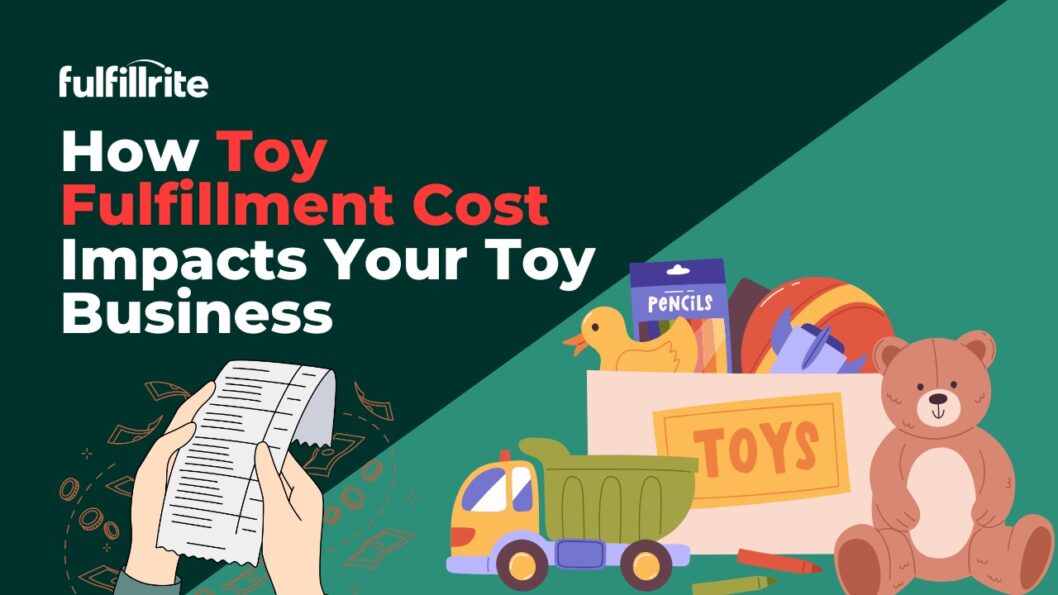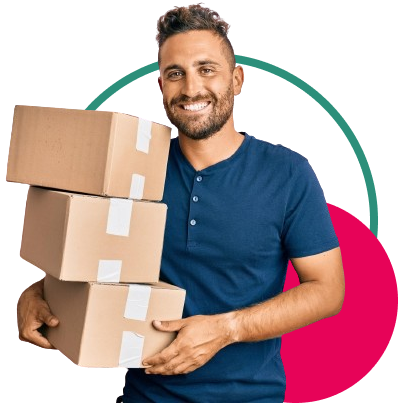You’ve got a great idea for a toy. Maybe it started as a sketch. Maybe you’ve already built a prototype. Or maybe you’ve had some success on Etsy or Kickstarter and you’re ready to scale.
No matter where you are in the journey, there’s one part of the toy business that’s easy to overlook until it becomes a problem: shipping.
Toy fulfillment cost can eat up your margins fast if you’re not paying attention. That goes double for new brands, small operations, and seasonal products. This post lays out what fulfillment really costs, how it ties into launching a real toy business, and what to expect as you scale.
Fulfillrite specializes in toy fulfillment for growing eCommerce brands. So if you feel like you’re ready to stop packing boxes yourself, give us a look.
But in the meantime, let’s start with the natural first question.
How do you start a toy company?
Starting a toy company is about creativity, but not creativity alone. It’s a business like any other—one with its own regulations, seasonality, and market pressures.
So before you even think about toy fulfillment cost, you need a plan.
1. Start with your niche.
Are you making plush toys? Wooden puzzles? STEM kits? Figurines? Pick a category you understand, ideally something that matches your skills or interests. Toy businesses thrive when they’re focused.
2. Decide how you’ll source your products.
Are you designing toys from scratch? White labeling? Dropshipping?
Most successful founders either build their own designs or work with reliable manufacturers to bring something unique to market.
3. Build and test your prototypes.
You can’t skip this. Toys have to be safe, especially if they’re for kids under 14.
In the U.S., you’ll need to comply with ASTM F963 (the standard for toy safety). That means choking hazard tests, chemical safety, and more. It also means you may need third-party testing labs before you can legally sell.
4. Know your customer.
Toys for toddlers aren’t the same as collectibles for adults. The age range affects everything: materials, safety warnings, marketing, and even where you can sell.
In short: the answer to “how do you start a toy company” is a lot more involved than just having a fun idea. But if you can get through those early steps, you’re well on your way.
How to plan your toy eCommerce operation
Once you’ve got a product that’s safe and ready to sell, it’s time to think eCommerce. This is where your toy business becomes a real company.
1. Pick the right eCommerce platform.
Shopify is the most common, and for good reason—it’s flexible, widely supported, and integrates with most fulfillment centers.
Amazon is powerful, but you’ll give up some control and a chunk of your margins.
WooCommerce is great if you’re already on WordPress, but it takes more setup.
2. Understand how toys eCommerce is different.
For one, toys are seasonal. Q4 (October to December) is everything. You’ll need to plan your inventory and marketing around that window.
Toys are also often gifted, which means higher stakes: late shipping or a broken item doesn’t just hurt you—it ruins someone’s holiday.
3. Presentation matters.
Your photos need to be top-notch. So do your product descriptions. And your return process needs to be smooth, especially if parents are buying for kids. Reviews will make or break your conversion rate, so deliver on your promises.
4. Manage your SKUs and inventory tightly.
Toys come in lots of variations. That makes tracking inventory tricky. Forecasting demand is hard, especially early on, but poor planning can mean excess storage fees, or worse, stockouts when orders roll in.
Everything you do here will directly affect your toy fulfillment cost.
What drives toy fulfillment cost?
Once you’ve got your toy business up and running, the next big cost bucket, after product and marketing, is fulfillment. And toy fulfillment cost can creep up fast if you don’t plan for it.
Here’s what actually drives the numbers:
1. Pick and pack labor.
Every order takes time to find, scan, box, and label. The more SKUs in your order, the more time it takes. If you’re bundling products, assembling kits, or adding inserts, that adds even more labor.
Some fulfillment centers charge per item picked. Others bundle it into an all-in-one fee. Either way, it’s real money.
2. Packaging.
Toys often need sturdy packaging. A collectible figure might ship in a custom die-cut insert. A plush might go in a poly mailer. The more fragile, oddly shaped, or high-end your toy, the more you’ll spend on materials and prep.
Overpackaging can waste money. But underpackaging risks returns, which cost more.
3. Storage fees.
Toys take up space. Big boxes. Awkward shapes. Slow movers. It adds up, especially during peak season.
Most 3PLs charge monthly for storage by pallet, bin, or cubic foot. Oversized toys cost more.
And if your stuff doesn’t move after the holidays? You’ll pay to keep it sitting there.
4. Shipping costs.
Shipping is always the wild card. It’s driven by weight, dimensions, speed, and destination. A small plush might ship for $4. A large building set might cost $15.
And if your customers are spread across the U.S. or abroad, those costs vary by zone. Choosing the right box sizes and carriers helps, as does working with a fulfillment partner who has good negotiated rates.
5. Returns.
Toys have a higher-than-average return rate, especially when bought as gifts. If something arrives broken, late, or not as expected, parents send it back.
Processing those returns takes time and labor, and some fulfillment centers charge for that separately.
DIY vs. 3PL
Doing it yourself means you pay in time. Renting your own space, hiring help, dealing with customer complaints—it’s all on you.
Outsourcing to a 3PL adds hard costs, but saves you the late nights and logistical headaches. Most growing toy brands start outsourcing when they hit 300–500 orders a month.
In short: toy fulfillment cost isn’t just a line item. It’s a whole set of decisions that shape how efficiently you can run your business.
How to reduce toy fulfillment costs (without sacrificing quality)
Cutting corners on fulfillment is a great way to lose customers. So the goal isn’t “cheap”—it’s efficient. Here’s how to manage toy fulfillment cost without hurting your customer experience.
1. Bundle your products.
Instead of shipping two or three individual SKUs per order, create bundles or kits. It reduces picking time, cuts packaging waste, and can even lower postage.
2. Work with a partner that understands toys.
Not all fulfillment centers are equipped to handle toys. Look for one that knows how to meet safety labeling requirements, deal with odd shapes and packaging, and handle spikes in Q4 volume.
Fulfillrite works with many toy companies and offers kitting, barcode scanning, and climate control where needed.
3. Right-size your packaging.
Don’t use a 12” cube box for something that fits in a padded mailer. Carriers charge based on dimensional weight.
That extra air in the box? It’s costing you.
4. Be smart with storage.
After the holidays, purge slow-moving SKUs or move them to long-term storage if your fulfillment center offers it.
Toy inventory tends to swell in Q4. Just don’t let it sit untouched through spring.
5. Use software integrations.
Syncing your orders automatically from Shopify, Amazon, or WooCommerce helps reduce mistakes. That means fewer failed shipments and less time spent chasing down errors.
There’s no magic bullet. But a few smart changes can make your toy fulfillment cost a lot more manageable, and keep customers happy while you do it.
What to look for in a toy fulfillment partner
Not every 3PL is built for toys. If you’re evaluating options, here’s what to look for:
1. Do they understand toys?
That includes handling fragile items, meeting labeling rules, and packaging products for kids and collectors alike.
2. Can they integrate with your platforms?
You need real-time order syncing with Shopify, WooCommerce, Amazon, and others.
Fulfillrite, like many fulfillment centers, offers strong integrations, which means less manual work for you.
3. Do they offer batching and kitting?
Especially important if you run monthly drops, crowdfunding campaigns, or bundles.
4. Can they scale for holidays?
Q4 is make-or-break for most toy businesses. Your partner should be ready to handle 5x or 10x your normal volume without falling apart.
5. What’s their communication like?
Can you reach a human? Will they flag low stock before it’s a problem? Do they tell you when something goes wrong?
Accuracy is great, but transparency is just as important.
Final Thoughts
Starting a toy business is exciting. But as soon as the orders start rolling in, you’re running a logistics operation, whether you meant to or not.
Calculating toy fulfillment costs might not be as fun as design or marketing. But it’s what keeps your customers happy and your margins intact.
Track your costs. Know what drives them.
And when you’re ready to stop packing boxes in your living room, talk to Fulfillrite. We can help you scale without losing sleep—or customers.

